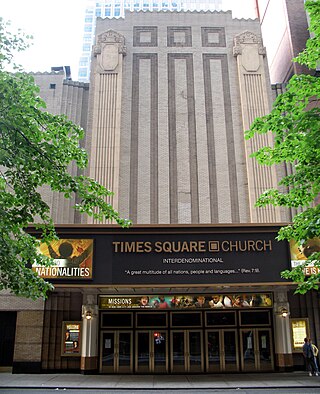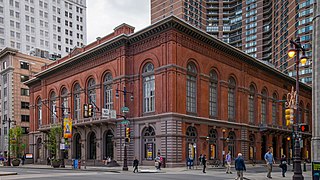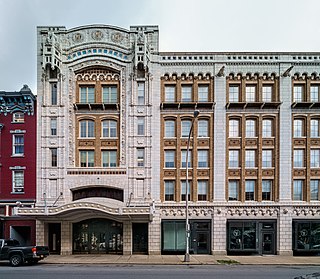
The Mark Hellinger Theatre is a church building at 237 West 51st Street in the Midtown Manhattan neighborhood of New York City, which formerly operated as a cinema and Broadway theater. Opened in 1930, the Hellinger Theatre is named after journalist Mark Hellinger and was developed by Warner Bros. as a movie palace. It was designed by Thomas W. Lamb with a modern facade and a Baroque interior. It has 1,605 seats across two levels and has been a house of worship for the Times Square Church since 1989. Both the exterior and interior of the theater are New York City landmarks.

The Ed Sullivan Theater is a theater at 1697–1699 Broadway, between 53rd and 54th Streets, in the Theater District of Midtown Manhattan in New York City. Built from 1926 to 1927 as a Broadway theater, the Sullivan was developed by Arthur Hammerstein in memory of his father, Oscar Hammerstein I. The two-level theater was designed by Herbert J. Krapp with over 1,500 seats, though the modern Ed Sullivan Theater was downsized to 370 seats by 2015. The neo-Gothic interior is a New York City landmark, and the building is on the National Register of Historic Places.

The Academy of Music, also known as American Academy of Music, is a concert hall and opera house located at 240 S. Broad Street in Philadelphia, Pennsylvania. Despite its name, the Academy has never contained a music school. It is located between Locust and Manning Streets in the Avenue of the Arts area of Center City.

Allerton Castle, also known as Allerton Park, is a Grade I listed nineteenth-century Gothic or Victorian Gothic house at Allerton Mauleverer in North Yorkshire, England. It was rebuilt by architect George Martin, of Baker Street, London in 1843–53.

The Hexagon is a multi-purpose theatre and arts venue in Reading, Berkshire, England. Built in 1977 in the shape of an elongated hexagon, the theatre is operated by Reading Borough Council under the name "Reading Arts and Venues" along with South Street Arts Centre and Reading's concert hall.

Martin Marietta Center for the Performing Arts is the premier location for cultural arts and entertainment in Raleigh, North Carolina. The center consists of four unique venues, Raleigh Memorial Auditorium, Meymandi Concert Hall, A.J. Fletcher Opera Theater, and Kennedy Theatre.

Bridlington Spa is a dance hall, theatre and conference centre in Bridlington, East Riding of Yorkshire, England. Refurbished between 2006 and 2008 and further updated with a new branding in 2016, the venue boasts a large Art Deco ball room, Edwardian theatre, art gallery and a selection of other meeting and event spaces; all featuring outstanding views over Bridlington's South Bay.

Proctor's Theater is located on Fourth Street in Troy, New York, United States. It was listed on the National Register of Historic Places in 1979, and is a contributing property to the Central Troy Historic District, added to the Register in 1986.
The Emery Theatre, or Emery Auditorium, is a historic, acoustically exceptional theater located in the Over-the-Rhine neighborhood of Cincinnati, Ohio. The building was constructed in 1911 as the home for a trade school, but its large auditorium was intended for public use. The design of the Emery Theatre is based on the "isacoustic curve" principles that were first proposed by John Scott Russell. The theatre was built with two balconies and a total of 2,211 seats. It was one of the first concert halls in the United States to have no obstructed seats.

The Orleans County Courthouse Historic District is one of two located in downtown Albion, New York, United States. Centered on Courthouse Square, it includes many significant buildings in the village, such as its post office and churches from seven different denominations, one of which is the tallest structure in the county. Many buildings are the work of local architect William V.N. Barlow, with contributions from Solon Spencer Beman and Andrew Jackson Warner. They run the range of architectural styles from the era in which the district developed, from Federal to Colonial Revival.

The area of New York's Capital District, also known as the Albany metropolitan area, has seen prominent historical events, artistic creations, and unique contributions to the culture of the United States since the 17th century. The largest city in the area, Albany, consistently ranks high on lists of top cities/metro areas for culture, such as being 23rd in the book Cities Ranked & Rated. The Albany-Schenectady-Troy metro area ranked 12th among large metro areas, and Glens Falls ranked 12th among the small metro areas, in Sperling's Best Places, and Expansion Management gave the Albany-Schenectady-Troy area five Stars, its highest ranking, for quality of life features.

Elbridge Boyden (1810–1898) was a prominent 19th-century American architect from Worcester, Massachusetts, who designed numerous civil and public buildings throughout New England and other parts of the United States. Perhaps his best known works are the Taunton State Hospital (1851) and Mechanics Hall (1855) in Worcester.

TheBritannia Music Hall in Trongate, Glasgow, Scotland is one of the oldest remaining music halls in Britain. It is located above an amusement arcade, at 113-117 Trongate.

Saint John's Lutheran Church is an active church building located at 121 South Locust Street in the city of Adrian in Lenawee County, Michigan. It was designated as a Michigan State Historic State on February 23, 1981 and shortly after listed on the National Register of Historic Places on December 27, 1984. The Lutheran congregation moved to a new home in 2007, and the church building now houses the Reformed Baptist Church of Lenawee.

The Joe R. and Teresa Lozano Long Center for the Performing Arts is a performing arts venue located along Lady Bird Lake in downtown Austin, Texas. The Long Center is the permanent home of the Austin Symphony Orchestra, Austin Opera and Ballet Austin and hosts other Austin-area performing arts organizations.

Coats Paisley is a reception hall which stands at the west end of the High Street in Paisley, Scotland.

Victoria Hall is located at 4626 Sherbrooke Street West in the City of Westmount, Quebec, Canada. It is situated adjacent to Westmount Public Library at the west side of Westmount Park. The original building, named Victoria Jubilee Hall, was destroyed by a fire in 1924 but was immediately rebuilt.

The Malco Theatre, located at 817 Central Avenue in Hot Springs, Arkansas, was built on a site that has housed vaudeville shows, silent movies, modern films, and specialty productions. The Malco, which was frequented by Bill Clinton as a boy, has played host to the prestigious Hot Springs Documentary Film Institute (HSDFI). The Art Deco building was added to the National Register of Historic Places on January 21, 2010. The Malco is currently home to the Maxwell Blade Theatre of Magic & Comedy.

Trinity United Methodist Church is a historic United Methodist church located in downtown Evansville, Indiana. The congregation began in 1825 as a Methodist class and its Gothic Revival style brick church building was completed in 1866. It was listed on the National Register of Historic Places in 1982.





















